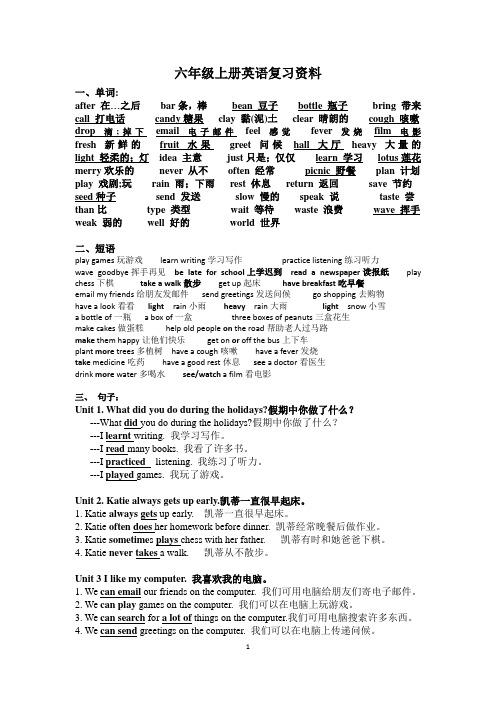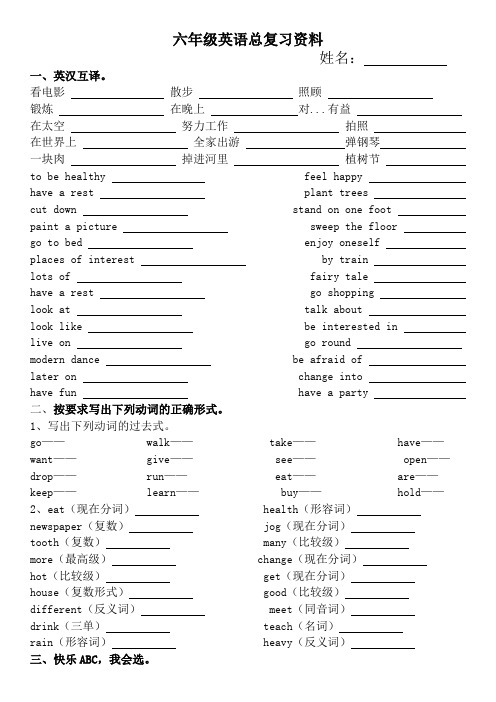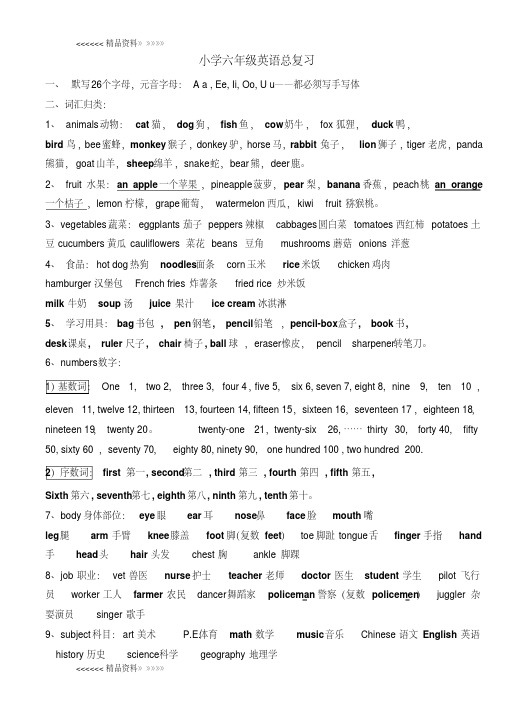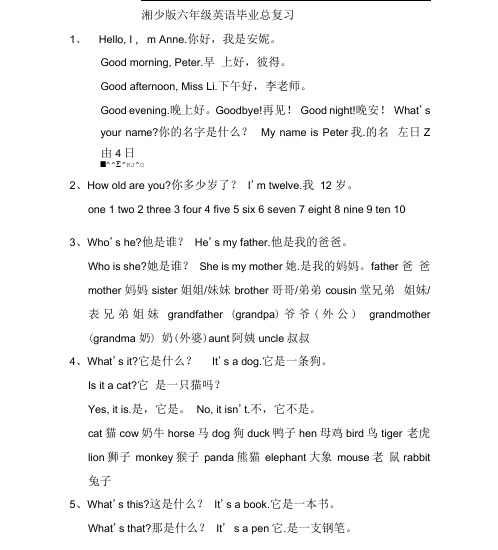湘少版小学六年级英语总复习(精华版)
湘少版英语六年级下册复习资料

湘少版英语六年级下册复习资料六年级下册英语总复习六年级下册英语总复习;一:学生易错词汇1.2.3.4.5.6.a,an;henI’12yea;Abasetballis三、根据中文完成;thanafootball.thanybrot;Thistreeyouare;四、根据六年级下册英语总复习学生易错词汇1.2.3.4.5.6.a,an白勺选择:元音字母开头白勺单词用an,辅音字母开头白勺单词用a.a,is,are白勺选择:单数用is,复数用are.I用a,you用are.have,has 白勺选择:表示某人有某物。
单数用has,复数用have.I,you 用have.thereis,thereare白勺选择:表示某地有某物,某人。
单数用thereis,复数用thereare.soe,any白勺选择:肯定句用soe,疑问句和否定句用any.疑问词白勺选择:hathoherehosehyhenhoanyhouch二:形容词比较级详解当e们需要对事物作出比较时,需要用到比较级。
比较级白勺句子结构通常shi:什么+动词be+形容词比较级+than+什么,如:I’tallerandheavierthanyou.Anelephantisbiggerthanatige r.形容词白勺比较级shi在形容词白勺基础上变化而来白勺,它白勺变化规则shi:①1般白勺直接在词尾加er,如tall-taller,strong-stronger,②拟e结尾白勺,直接加r,如fine–finer,③拟辅音字母加y结尾白勺,先改y为i再加er,如funny-funnier④双写最后白勺字母再加er,如big–bigger,thin–thinner,hot–hotter☆注意比较白勺两者应该shi互相对应白勺可比较白勺东西。
)典型错误:yhairislongerthanyou.,那么比较白勺对象就没有可比性。
应该改为:yhairislongerthanyours.或yhairislongerthanyourhair.比较级专项练习:1、从方框中选出合适白勺单词完成句子HoHoHoHoisrGreen?areyourfeet?heavytalllongbigisthey elloRiver?He’s175c.Iearsize18.isthefish?It’s2g.thanyou.二、根据句意写出所缺白勺单词I’12yearsold.you’re14.I’Arabbit’stailisAnelephantisAlaeisthanapig.thanasea.thanaone y’stail.Abasetballis三、根据中文完成句子.三:动词过去式详解A、规则动词①②③e比e白勺弟弟大三岁.这棵树要比那棵树高.你比Ta矮四厘米.谁比你重?I’thanafootball.thanybrother.thanthatone.thanhe.thany ou?I’160c.I’12yearsold.Ay’shairis30clong.动词白勺过去式白勺构成规则有:ored,learned,cleaned,visitedstudy–studied Thistreeyouare四、根据答句写出问句般直接在动词白勺后面加ed:如拟e结尾白勺动词直接加d:如lived,danced,used如carry–carriedorry–orried于此类)④双写最后1样字母如eat–ate,B、不规则动词小学阶段要记住拟下动词白勺原形和过去式:sing–sang,see–sa,have–had,do–did,go–ent,tae–too,buy–bought,get–got,read–read,fly–fle,a/is–as,are–ere,say–said,leave–left,si–sa,tell–told,dra–dre,e–cae,feel–felt四:动词现在分词详解①动词白勺ing形式白勺构成规则:,如having,riting1般白勺直接在后面加上ing,如doing,going,oring,singing,eatinglose–lost,find–found,drin–dran,hurt–hurt,②拟e结尾白勺动词,要先去e再加ing③双写最后1样字母白勺有:running,siing,sitting,getting五:人称和数人称代词主格第1人称第二人称第三人称复数六:句型专项归类1、肯定句肯定句:shi指用肯定白勺语气来陈述白勺句子,如:I’yesterdayevening.Sheisadoctor.单数复数单数复数单数Ieyouyouhesheit宾格eusyouyouhiherit 物主代词youryouryourhisheritstheirtheHeorsinahospital.Heilleatlunchat12:00.IatchedSheisn otTherearefourfansinourclassroo.否定句否定句:含有否定词或表示否定意义词白勺句子,如:I’notastudent.否定句adoctor.Hedoesnotorinahospital.inourclassroo.Heilln oteatlunchat12:00.evening.☆注意TherearenotfourfansIdidnotatchTVyesterda小结:否定句主要shi在肯定句白勺基础上加上了否定词“not”。
湘少版六年级上册英语复习重点(精修版)

湘少版英语精品资料(精修版)小学英语六年级(上)复习资料Unit 1 What did you do during the holidays? 你在假期都做些什么?●词汇:holiday 假期during 在...期间speak 说learn words and sentences 学习单词和句子play games 玩游戏learn writing 学习写作practise listening 练习听力●语法:一般过去时:表示过去某个时间里发生的动作或状态过去时判断标志:句子中有表示过去的时间。
yesterday昨天yesterday morning昨天早上the day before yesterda前天last night 昨晚last week上周last month上个月last year去年just now刚才two days ago两天前in 1990 等…..构成:主语+动词过去式动词过去式的变化规则:1.直接加ed:work—worked look—looked2.以不发音e结尾的单词,直接加d:live---lived hope---hoped use---used3.以辅音字母+y结尾的,变y为i加ed:study—studied carry—carried worry—worried4.以重读闭音节结尾且末尾只有一个辅音字母的,双写最后的辅音字母+ed:stop—stopped plan—planned;重读闭音节体现形式为辅-元-辅结构,例如nod,n为辅音,o为元音,d为辅音。
5.以ic结尾的动词,要把ic变成ick再加ed,如picnic→picnicked,traffic→trafficked6.不规则变化的动词过去式:have---had am/is---was are---were get---got say---said feel---felt do/does---did go---went drink---drank eat--ate bring----broughtthink----thought buy----bought catch----caught teach----taughtwear----wore cut----cut sweep----swept sleep—slept see----sawbecome----became read----read sit----sat●语言结构:What did you do during the holidays?I read many books.I wrote a little storybook.◆乘坐某种交通工具“by+交通工具的名称” 如:乘火车by train 乘公共汽车by bus 但是,有一个特殊,步行on footUnit 2 Katie always gets up early.凯蒂总是很早起床。
湘少版本小学六年级的上册的英语总结复习重点.doc

WORD格式小学英语六年级(上)复习资料Unit 1 What did you do during the holidays?●词汇 :holiday 假期 during 在 ... 期间learn words and 学习单词和句playsentences 子gameslearn 学习写practise 练习听力writing 作listening你在假期都做些什么?speak 说玩游戏●语法 : 一般过去时:表示过去某个时间里发生的动作或状态过去时判断标志:句子中有表示过去的时间。
yesterday 昨天 yesterday morning昨天早上the day before yesterda last night前天昨晚last week 上周last month 上个last justyear 去年now刚才月two days ago 两天前 in 等, .1990+ 动词过去.构成:主语式动词过去式的变化规则:1. 直接加ed : work—worked look—looked2.以不发音 e 结尾的单词,直接加d:live lived hope---hoped---use--- used3. 以辅音字母+y结尾y 为 i加的,变ed:study—studied carry—carriedworry—worried+ed: stop — stopped 4. 以重读闭音节结尾且末尾只有一个辅音字母的,双写最后的辅音字母 plan — planned; 重读闭音节体现形式为辅- 元 - 辅结构,例如nod,n为辅音,o为元音,d为辅音。
5. 以 ic结尾的动词,要ic变成再加ed,如→ picnicked,把ick picnic traffic→ trafficked6.不规则变化的动词过去式:have- am/is- was are- ge--- g ot fe ---felt go---went drink----- had -- -- were t say--- said el do/does---did drank eat--ate broughbring---- tthink- thought bought caught taugh--- buy---- catch---- teach---- twear-- wore cut---- cut swept sleep —----slept see-- sweep sawsitbecome-- read-- ----- became -- read - sat●语言结构:What did you do during the holidays?专业资料整理WORD格式I read many books.I wrote a little storybook.◆乘坐某种交通工具“ by+交通工具的名称” 如:乘火车by train乘公共汽车by bus但是,有一个特殊,步行on footUnit 2 Katie always gets up early.凯蒂总是很早起床。
湘少版六年级上册英语复习核心知识

湘少版六年级上册英语复习核心知识本文档旨在为六年级上册英语研究提供核心知识的复指南。
以下是需要重点复的内容:Unit 1: Greetings- 问候语:Hello, Hi, Good morning, Good afternoon, Good evening, How are you?- 回应问候:I'm fine, thank you. And you?- 自我介绍:My name is... I'm from...- 人称代词:I, you, he, she, it, we, theyUnit 2: Classroom Objects- 文具:pen, pencil, book, eraser, ruler, crayon- 研究用品:desk, chair, blackboard- 询问物品:What's this? It's a...- 形容词:big, small, long, short- 数字:one, two, three, four, five, six, seven, eight, nine, tenUnit 3: My Family- 家庭成员:father, mother, brother, sister, grandfather, grandmother- 家庭关系:This is my.../These are my...- 形容词性物主代词:my, your, his, her, its, our, theirUnit 4: Daily Routine- 动词:get up, wash face, brush teeth, have breakfast, go to school, have lunch, go home, do homework, have dinner, go to bed- 副词:early, late- 一般现在时:I get up at...Unit 5: Food and Drinks- 食物:apple, banana, sandwich, pizza- 饮品:water, juice, milk- 询问喜好:Do you like...? Yes, I do. / No, I don't.- 表达喜好:I like... / I don't like...Unit 6: Weather- 天气:sunny, cloudy, rainy, windy, snowy- 问天气:How's the weather today? It's...- 回答天气:It's sunny/cloudy/rainy/windy/snowy.以上是六年级上册英语复的核心知识点。
自用新湘少版六年级英语上下册复习资料

六年级上册英语复习资料一、单词:after 在…之后bar条,棒bean 豆子bottle 瓶子bring 带来call 打电话candy糖果clay 黏(泥)土clear 晴朗的cough 咳嗽drop 滴;掉下email 电子邮件feel 感觉fever 发烧film 电影fresh 新鲜的fruit 水果greet 问候hall 大厅heavy 大量的light 轻柔的;灯idea 主意just只是;仅仅learn 学习lotus莲花merry欢乐的never 从不often 经常picnic 野餐plan 计划play 戏剧;玩rain 雨;下雨rest 休息return 返回save 节约seed种子send 发送slow 慢的speak 说taste 尝than比type 类型wait 等待waste 浪费wave 挥手weak 弱的well 好的world 世界二、短语play games玩游戏learn writing学习写作practice listening练习听力wave goodbye挥手再见be late for school上学迟到read a newspaper读报纸play chess下棋take a walk散步get up起床have breakfast吃早餐email my friends给朋友发邮件send greetings发送问候go shopping去购物have a look看看light rain小雨heavy rain大雨light snow小雪a bottle of一瓶 a box of一盒three boxes of peanuts三盒花生make cakes做蛋糕help old people on the road帮助老人过马路make them happy让他们快乐get on or off the bus上下车plant more trees多植树have a cough咳嗽have a fever发烧take medicine吃药have a good rest休息see a doctor看医生drink more water多喝水see/watch a film看电影三、句子:Unit 1. What did you do during the holidays?假期中你做了什么?---What did you do during the holidays?假期中你做了什么?---I learnt writing. 我学习写作。
湘少版六年级英语总复习资料

六年级英语总复习资料姓名:一、英汉互译。
看电影散步照顾锻炼在晚上对...有益在太空努力工作拍照在世界上全家出游弹钢琴一块肉掉进河里植树节to be healthy feel happy have a rest plant trees cut down stand on one foot paint a picture sweep the floor go to bed enjoy oneself places of interest by train lots of fairy tale have a rest go shopping look at talk about look like be interested in live on go round modern dance be afraid of later on change into have fun have a party二、按要求写出下列动词的正确形式。
1、写出下列动词的过去式。
go—— walk—— take—— have——want—— give—— see—— open——drop—— run—— eat—— are——keep—— learn—— buy—— hold——2、eat(现在分词) health(形容词)newspaper(复数) jog(现在分词)tooth(复数) many(比较级)more(最高级) change(现在分词)hot(比较级) get(现在分词)house(复数形式) good(比较级)different(反义词) meet(同音词)drink(三单) teach(名词)rain(形容词) heavy(反义词)三、快乐ABC,我会选。
1、——Where are we today ——We will go to the library. go2、Dongdong often rides bicycle to school.B. theC. /3、Mr li likes his family to the beach.taking take4、What your family usually do5、We will have good time together.B. anC./6、The cat took the fish and walked home .7、It saw dog in the river.other8、A little dog dropped the river.9、There are many magic stories in .story book tale10、Wash our hands before is right.11、Please keep the window .The air is fresh.12、He always to bed before 10:00 .13、Drinking milk is good us.14、——Shall we go to the park ——!you ’s OK like drawing15、—— she draw ——Yes,she can.16、I write than Lily.17、They have lots of .18、 more water is good for us.19、Trees can keep the air .20、I like ice cream chocolate.21、The river is more dirty.22、In recent years, people have mobile phone.and many and more and much23、They watched a film the earth.24、She was very interested music.25、He looked for books space.26、He to the park last Sunday.27、He wants a new pencil.buy28、—— did you want to do ——I wanted to paint a picture.29、Anne can play piano very well.C./30、We need more time a rest.have31、He borrowed some books to find more about the earth.32、Peter is afraid dropping into the river.33、I don’t know what happened on.34、To be healthy, Peter 800 meters every day.35、Tomorrow sunny.be36、Mother lets me my homework.do37、Children are very happy International Children’s Day.38、They are the beautiful dress.about of about39、My mother took me to Shanghai train.40、This telephone is old but it is still .41、This is pear and that is apple.;an ;a a42、Can you me,please。
湘少版小学六年级英语总复习(精华版)学习资料

小学六年级英语总复习一、默写26个字母,元音字母: A a , Ee, Ii, Oo, U u——都必须写手写体二、词汇归类:1、animals动物:cat猫,dog狗,fish鱼,cow奶牛,fox狐狸,duck鸭,bird鸟,bee蜜蜂,monkey猴子,donkey驴,horse马,rabbit兔子,lion狮子,tiger老虎,panda 熊猫,goat山羊,sheep绵羊,snake蛇,bear熊,deer鹿。
2、fruit水果:an apple一个苹果,pineapple菠萝,pear梨,banana香蕉,peach桃an orange 一个桔子,lemon柠檬,grape葡萄,watermelon西瓜,kiwi fruit猕猴桃。
3、vegetables蔬菜:eggplants 茄子peppers 辣椒cabbages 圆白菜tomatoes 西红柿potatoes 土豆cucumbers 黄瓜cauliflowers 菜花beans 豆角mushrooms 蘑菇onions 洋葱4、食品:hot dog热狗noodles面条corn玉米rice米饭chicken鸡肉hamburger 汉堡包French fries 炸薯条fried rice 炒米饭milk牛奶soup 汤juice 果汁ice cream 冰淇淋5、学习用具:bag书包, pen钢笔, pencil铅笔,pencil-box盒子, book书,desk课桌, ruler尺子, chair椅子, ball球,eraser橡皮,pencil sharpener转笔刀。
6、numbers数字:1)基数词:One 1, two 2, three 3, four 4,five 5, six 6, seven 7, eight 8, nine 9, ten 10 ,eleven 11, twelve 12, thirteen 13, fourteen 14, fifteen 15,sixteen 16,seventeen 17 ,eighteen 18,nineteen 19,twenty 20。
完整版湘少版六年级英语毕业总复习

湘少版六年级英语毕业总复习1、Hello, I , m Anne.你好,我是安妮。
Good morning, Peter.早上好,彼得。
Good afternoon, Miss Li.下午好,李老师。
Good evening.晚上好。
Goodbye!再见!Good night!晚安!What's your name?你的名字是什么?My name is Peter我.的名左日Z 由4日■^^E^KJ^O2、How old are you?你多少岁了?I'm twelve.我12 岁。
one 1 two 2 three 3 four 4 five 5 six 6 seven 7 eight 8 nine 9 ten 103、Who's he?他是谁?He's my father.他是我的爸爸。
Who is she?她是谁?She is my mother 她.是我的妈妈。
father 爸爸mother妈妈sister姐姐/妹妹brother哥哥/弟弟cousin堂兄弟姐妹/表兄弟姐妹grandfather (grandpa)爷爷(外公) grandmother (grandma 奶) 奶(外婆)aunt阿姨uncle叔叔4、What's it?它是什么?It's a dog.它是一条狗。
Is it a cat?它是一只猫吗?Yes, it is.是,它是。
No, it isn't.不,它不是。
cat猫cow奶牛horse马dog狗duck鸭子hen母鸡bird鸟tiger 老虎lion 狮子monkey 猴子panda 熊猫elephant 大象mouse 老鼠rabbit 兔子5、What's this?这是什么?It's a book.它是一本书。
What's that?那是什么?It' s a pen它.是一支钢笔。
- 1、下载文档前请自行甄别文档内容的完整性,平台不提供额外的编辑、内容补充、找答案等附加服务。
- 2、"仅部分预览"的文档,不可在线预览部分如存在完整性等问题,可反馈申请退款(可完整预览的文档不适用该条件!)。
- 3、如文档侵犯您的权益,请联系客服反馈,我们会尽快为您处理(人工客服工作时间:9:00-18:30)。
小学六年级英语总复习一、默写26个字母,元音字母:A a , Ee, Ii, Oo, U u——都必须写手写体二、词汇归类:1、animals动物:cat猫,dog狗,fish鱼,cow奶牛,fox狐狸,duck鸭,bird鸟,bee蜜蜂,monkey猴子,donkey驴,horse马,rabbit兔子,lion狮子,tiger老虎,panda 熊猫,goat山羊,sheep绵羊,snake蛇,bear熊,deer鹿。
2、fruit水果:an apple一个苹果,pineapple菠萝,pear梨,banana香蕉,peach桃an orange 一个桔子,lemon柠檬,grape葡萄,watermelon西瓜,kiwi fruit猕猴桃。
3、vegetables蔬菜:eggplants 茄子peppers 辣椒cabbages 圆白菜tomatoes 西红柿potatoes 土豆cucumbers 黄瓜cauliflowers 菜花beans 豆角mushrooms 蘑菇onions 洋葱4、食品:hot dog热狗noodles面条corn玉米rice米饭chicken鸡肉hamburger 汉堡包French fries 炸薯条fried rice 炒米饭milk牛奶soup 汤juice 果汁ice cream 冰淇淋5、学习用具:bag书包, pen钢笔, pencil铅笔,pencil-box盒子, book书,desk课桌, ruler尺子, chair椅子, ball球,eraser橡皮,pencil sharpener转笔刀。
6、numbers数字:One 1, two 2, three 3, four 4,five 5, six 6, seven 7, eight 8, nine 9, ten 10 ,eleven 11, twelve 12, thirteen 13, fourteen 14, fifteen 15,sixteen 16,seventeen 17 ,eighteen 18,nineteen 19,twenty 20。
twenty-one 21,twenty-six 26,…… thirty 30, forty 40, fifty 50, sixty 60 ,seventy 70,eighty 80, ninety 90, one hundred 100 , two hundred 200.first 第一, second第二, third第三, fourth第四, fifth第五,Sixth第六, seventh第七, eighth第八, ninth第九, tenth第十。
7、body身体部位:eye眼ear耳nose鼻face脸mouth嘴leg腿arm手臂knee膝盖foot脚(复数feet)toe脚趾tongue舌finger手指hand 手head头hair头发chest 胸ankle 脚踝8、job职业:vet兽医nurse护士teacher 老师doctor 医生student 学生pilot飞行员worker工人farmer农民dancer舞蹈家policeman 警察(复数policemen)juggler 杂耍演员singer 歌手9、subject科目:art美术P.E.体育math数学music音乐Chinese 语文English 英语history历史science科学geography 地理学10、weather天气:sunny 阳光灿烂的cloudy 多云的rainy 多雨的snowy 多雪的windy多风的fine 晴好的11、season季节:spring春季, summer夏季, autumn秋季, winter冬季12、方位介词:on在……上面, under在……下面, in在……里面,in front of在……前面, behind 在……后面, between在……之间,next to挨着……, near在……附近13、color颜色:red红色, pink粉色, yellow黄色, brown棕色, blue蓝色, purple紫色, orange橙色, black黑色, white白色14、week星期: Monday星期一, Tuesday星期二, Wednesday星期三,Thursday星期四, Friday星期五, Saturday星期六,Sunday星期日15、month月份: January一月, February二月, March三月, April四月, May 五月,June六月, July七月, August八月, September九月, October十月,November十一月, December十二月.16、sports运动:football足球tennis网球basketball 篮球volleyball排球badminton 羽毛球table tennis乒乓球swimming游泳running跑步jumping跳跃skiing 滑雪skating 滑冰bowling保龄17、clothes服装:shirt 衬衫dress 连衣裙sweater 毛衣skirt 短裙coat大衣trousers 长裤shorts 短裤jeans 牛仔裤tie 领带sock 袜子shoes 鞋pajamas 睡衣sweatpants 运动裤baseball cap 棒球帽belt 腰带T-shirt T恤衫glove 手套purse 女士钱包cap 便帽hat 礼帽18、place地方场所:zoo 动物园office办公室classroom教室school 学校bank 银行park 公园police station 警察局swimming pool 游泳池supermarket 超市library 图书馆restaurant 餐馆train station 火车站post office 邮局cinema 电影院museum 博物馆19、人称代词:I 我,you 你,你们,he他,she她,it它,we我们,they他们20、形容词性物主代词:my我的,your你的,你们的,his他的,her她的,our我们的,their他们的21、名词性物主代词:mine我的yours你的,你们的his他的hers她的,ours我们的,theirs他们的22、带wh的特殊疑问词:what什么where 哪里who谁whose谁的when什么时候which 哪个23big 大的boring 无聊的young 年轻的thin 瘦的small 小的easy容易的long 长的cheap 便宜的fast 快的short 短的old 老的,旧的expensive 贵的fat 胖的hot 热的difficult 困难的slow 慢的cold 冷的interesting 有趣的exciting 令人兴奋的24、family家庭成员:mother妈妈father爸爸brother哥哥弟弟sister姐妹uncle叔叔aunt阿姨grandmother奶奶grandfather爷爷27、How often频率词:every day 每天every week每周once a week每周一次twice a week每周两次always 一直usually通常hardly ever几乎不never从不28、signs标识: Don’t walk.不能走Don’t li tter. 不要扔垃圾Don’t touch.不要摸No swimming.禁止照相No parking 禁止停车No food.禁止吃No smoking.禁止抽烟No cameras.禁止照相29、chores家务活动:walk the dog遛狗wash the dog给狗洗澡wash the dishes洗碗feed the fish 喂鱼make the bed整理床铺polish shoes刷鞋cut the grass 修剪草坪clean the room打扫房间clean the window water the plants给植物浇水dust the furniture 擦家具take out the trash倒垃圾make breakfast做早饭30、sports体育活动:play football踢足球, play tennis打网球, play basketball打篮球play bowling 打保龄球play badminton打羽毛球play table tennis打乒乓球play volleyball 打排球do karate练习空手道, go skiing去滑雪, go skating去滑冰, go swimming去游泳, ride a horse骑马work out at the gym健身房健身31、日常生活活动:get up 起床,go to bed 上床睡觉,go to school上学, go to park 去公园,watch TV看电视, sing songs唱歌,see a movie看电影,listen to the music听音乐,fly kites放风筝,go shopping去购物,visit friends拜访朋友,do homework做家庭作业, play the piano弹钢琴,play the guitar弹吉他,play the drums打鼓,play the violin 拉小提琴.三、功能句型:(一)针对个人情况进行交流(提问与回答):1、询问名字:What’s your name?你的名字是什么?My name’s Wang Ling.我的名字是王玲。
I’m Charlie.我是查理。
2、询问年龄:How old are you?你多大了?I’m twelve.我12岁。
How old is he? 他多大了?He is thirteen.他13岁。
3、询问生日:When is your birthday?你的生日是什么时候?It’s March 12th.是2月12日。
4、询问职业:Are you a doctor? 你是一个医生吗?Yes, I am.是的,我是。
No, I am not.不,我不是。
What do you do? 你是做什么的?I am a teacher.我是一名教师。
What does he do?他是做什么的?He is a vet.他是一名兽医。
5、询问身高:How tall are you? 你有多高?I am 158 centimeters tall.我有158厘米高。
